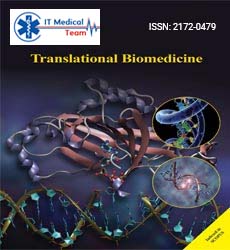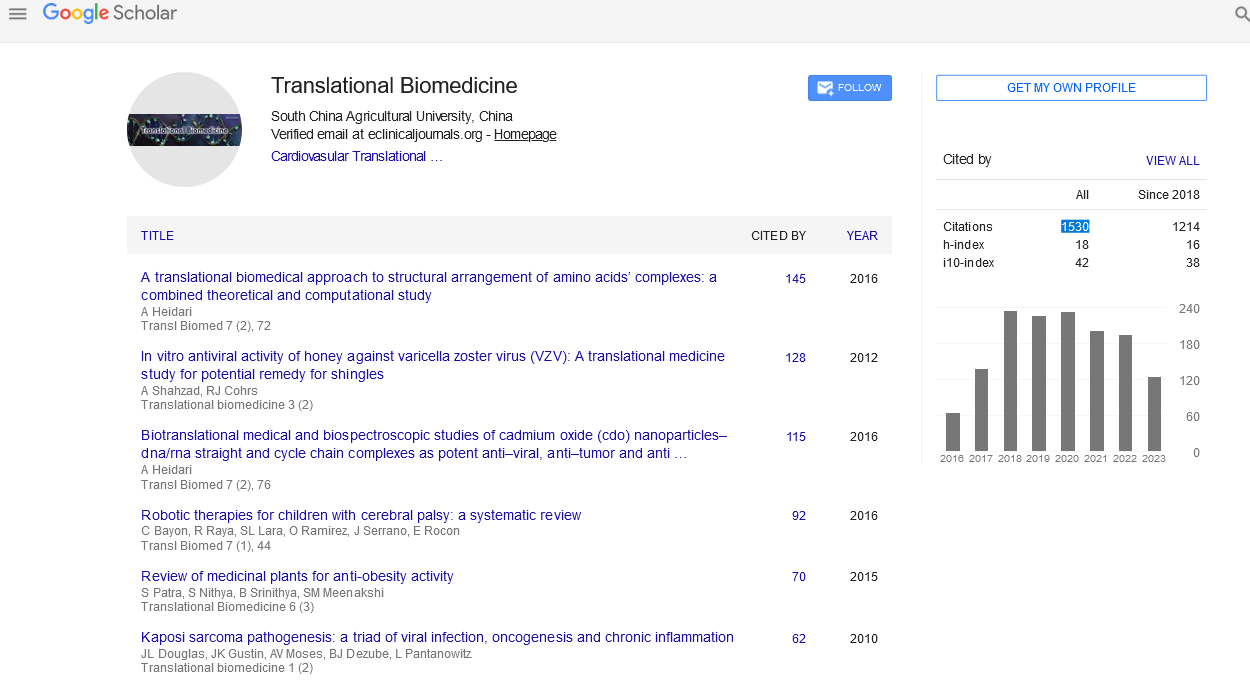Case Report - (2023) Volume 14, Issue 4
Revolutionizing Healthcare: The Promise of Regenerative Medicine
Krishna Patel*
Department of Regenerative Medicine, India
*Correspondence:
Krishna Patel, Department of Regenerative Medicine,
India,
Email:
Received: 01-Jul-2023, Manuscript No. iptb-23-13869;
Editor assigned: 05-Jul-2023, Pre QC No. iptb-23-13869;
Reviewed: 21-Jul-2023, QC No. iptb-23-13869;
Revised: 26-Jul-2023, Manuscript No. iptb-23-13869;
Published:
31-Jul-2023
Abstract
Regenerative medicine has emerged as a transformative field at the intersection of biology, engineering, and genetics, with the potential to revolutionize healthcare. This multidisciplinary approach focuses on harnessing the body's natural regenerative capabilities to restore, replace, or regenerate damaged tissues and organs. Through cellular therapies, tissue engineering, and biomaterials, regenerative medicine offers innovative solutions for previously incurable diseases and injuries. Stem cell therapies, tissue engineering techniques, and advanced biomaterials have shown promising results in preclinical and clinical studies. Challenges such as cell sourcing, differentiation, and immune rejection need to be addressed for widespread implementation. Nonetheless, regenerative medicine holds tremendous promise for personalized treatments, improved patient outcomes, and the future of healthcare.
Keywords
Regenerative medicine; Cellular therapies; Tissue
engineering; Biomaterials; Stem cell therapy; Organ regeneration;
Personalized treatments; Healthcare revolution; Preclinical studies
INTRODUCTION
In recent years, regenerative medicine has emerged as a
ground-breaking field with the potential to revolutionize the
landscape of healthcare [1]. This rapidly evolving discipline
combines the latest advances in biology, engineering,
genetics, and other scientific domains to develop innovative
solutions for previously incurable diseases and injuries. By
harnessing the body's natural regenerative capabilities and
leveraging advanced technologies, regenerative medicine
aims to restore, replace, or regenerate damaged tissues and
organs, offering new hope to patients worldwide [2]. The
field of regenerative medicine focuses on three primary
strategies: cellular therapies, tissue engineering, and
biomaterials. Cellular therapies involve the transplantation
or stimulation of healthy cells to replace or regenerate
damaged cells or tissues. Stem cell therapy, a prominent
example within this category, utilizes the remarkable
potential of pluripotent or multipotent cells to differentiate
into various cell types [3]. These cells can be sourced from
different origins, including embryonic tissue, adult tissues,
and induced pluripotent stem cells (iPSCs). Through stem
cell therapies, conditions such as spinal cord injuries,
heart disease, and neurodegenerative disorders are being
targeted with renewed hope for effective treatments. Tissue
engineering represents another vital aspect of regenerative
medicine [4]. It aims to create functional and viable
tissues and organs in the laboratory for transplantation.
By combining scaffolds, growth factors, and cells, tissue
engineers strive to mimic the natural environment
necessary for tissue development and regeneration [5]. This
approach holds the potential to address the shortage of
organs available for transplantation, particularly for organs
in high demand such as kidneys and livers. Through the
advancements in tissue engineering, patients' quality of
life can be significantly improved by providing them with
the option of organ replacement without the challenges
associated with organ transplantation waiting lists.
Biomaterials, a crucial component of regenerative medicine,
play a pivotal role in providing support and guidance for
tissue repair and regeneration [6]. These materials can be
engineered to mimic the extracellular matrix, providing a
scaffold for cells to adhere, proliferate, and differentiate.
Furthermore, biomaterials can be designed to release
growth factors or other bioactive molecules, creating an
optimal microenvironment for tissue regeneration [7]. The
advancements in biomaterials, including the development
of 3D-printed scaffolds and nanomaterials, are driving
the progress of regenerative medicine and expanding the
possibilities for successful tissue regeneration. Regenerative medicine has already demonstrated promising clinical
applications and success stories [8]. For instance,
regenerative therapies have been successfully employed to
treat skin burns and chronic wounds. By utilizing cell-based
therapies and bioengineered skin substitutes, patients with
extensive burns experience improved healing and reduced
scarring. Additionally, regenerative approaches have shown
potential in cardiac tissue repair, with on-going research
investigating the regeneration of functional heart muscle
following heart attacks [9]. These successes highlight the
potential of regenerative medicine to transform patient
care and address previously untreatable conditions.
MATERIAL AND METHODS
Understanding regenerative medicine
Regenerative medicine encompasses a multidisciplinary
approach, combining biology, engineering, genetics,
and other scientific disciplines to develop therapies that
promote the body's own healing mechanisms [10]. The
field focuses on three primary strategies: cellular therapies,
tissue engineering, and biomaterials. These strategies aim
to address the limitations of traditional treatments and
provide long-term solutions to complex medical challenges.
Cellular therapies
Cell-based therapies involve the transplantation or
stimulation of healthy cells to replace or regenerate
damaged cells or tissues. Stem cell therapy, a prominent
example, utilizes the remarkable potential of pluripotent
or multipotent cells to differentiate into various cell
types. These cells can be obtained from different sources,
including embryonic tissue, adult tissues, and induced
pluripotent stem cells (iPSCs). Through stem cell therapies,
conditions such as spinal cord injuries, heart disease,
and neurodegenerative disorders are being targeted with
renewed hope.
Tissue engineering
Tissue engineering aims to create functional and viable tissues and organs in the laboratory for transplantation.
By combining scaffolds, growth factors, and cells, tissue
engineers strive to mimic the natural environment
necessary for tissue development and regeneration. This
approach offers the potential to replace organs that are
in high demand, such as kidneys and livers, reducing
the burden on organ transplantation waiting lists and
improving patients' quality of life.
Biomaterials
Biomaterials play a crucial role in regenerative medicine
by providing support and guidance for tissue repair and
regeneration. These materials can be engineered to mimic the
extracellular matrix, providing a scaffold for cells to adhere,
proliferate, and differentiate. Additionally, biomaterials
can be designed to release growth factors or other bioactive
molecules, creating an optimal microenvironment for tissue
regeneration. From 3D-printed scaffolds to nanomaterials,
advancements in biomaterials are driving the progress of
regenerative medicine.
Clinical applications and success stories
Regenerative medicine has already demonstrated its
potential in various clinical applications. One notable
success story is the use of regenerative therapies to treat
skin burns and chronic wounds. By employing cell-based
therapies and bioengineered skin substitutes, patients
with extensive burns can experience improved healing
and reduced scarring. Another remarkable advancement is
the use of regenerative approaches in cardiac tissue repair,
with on-going research investigating the regeneration of
functional heart muscle following heart attacks.
Challenges and future directions
Despite its immense potential, regenerative medicine
faces significant challenges. Obtaining a sufficient number
of viable cells, ensuring their proper differentiation, and
preventing immune rejection are among the key hurdles
that need to be overcome. Additionally, the high costs
associated with research, development, and clinical
implementation pose barriers to widespread adoption.
REFERENCES
- Bleyer WA. Cancer in older adolescents and young adults: Epidemiology diagnosis treatment, survival and importance of clinical trials. Med Pediatr Oncol. 2002; 38(15): 1–10.
Indexed at, Google Scholar, Crossref
- Liu L, Krailo M, Reaman GH. Childhood cancer patients' access to cooperative group cancer programs: A population-based study. Cancer. 2003; 97(15): 1339–1345.
Indexed at, Google Scholar, Crossref
- Pastore G, De Salvo GL, Bisogno G. Evaluating access to pediatric cancer care centers of children and adolescents with rare tumors in Italy: The TREP project. Pediatr Blood Cancer. 2009; 53(13): 152–155.
Indexed at, Google Scholar, Crossref
- Ferrari A, Miceli R, Casanova M. The symptom interval in children and adolescents with soft tissue sarcomas. Cancer. 2010; 116(35): 177–183.
Indexed at, Google Scholar, Crossref
- Dang-Tan T, Trottier H, Mery LS. Delays in diagnosis and treatment among children and adolescents with cancer in Canada. Pediatric Blood & Cancer. 2008; 51(25): 468–474.
Indexed at, Google Scholar, Crossref
- Bleyer A, Barr R, Hayes-Lattin B. The distinctive biology of cancer in adolescents and young adults. Nat Rev Cancer. 2008; 8(3): 288–298.
Indexed at, Google Scholar, Crossref
- Ribeiro RC, Sandrini F, Figueiredo B. An inherited p53 mutation that contributes in a tissue-specific manner to pediatric adrenal cortical carcinoma. Proc Natl Acad Sci U S A. 2001; 98(45): 9330–9335.
Indexed at, Google Scholar, Crossref
- Hill DA, Jarzembowski JA, Priest JR. Type I pleuropulmonary blastoma: Pathology and biology study of 51 cases from the international pleuropulmonary blastoma registry. Am J Surg Pathol. 2008; 32(25): 282–295.
Indexed at, Google Scholar, Crossref
- Priest JR, Watterson J, Strong L. Pleuropulmonary blastoma: A marker for familial disease. J Pediatr. 1996; 128(55): 220–224.
Indexed at, Google Scholar, Crossref
- Strouse JJ, Fears TR, Tucker MA. Pediatric melanoma: Risk factor and survival analysis of the surveillance, epidemiology and end results database. J Clin Oncol. 2005; 23(12): 4735–4741.
Indexed at, Google Scholar, Crossref





